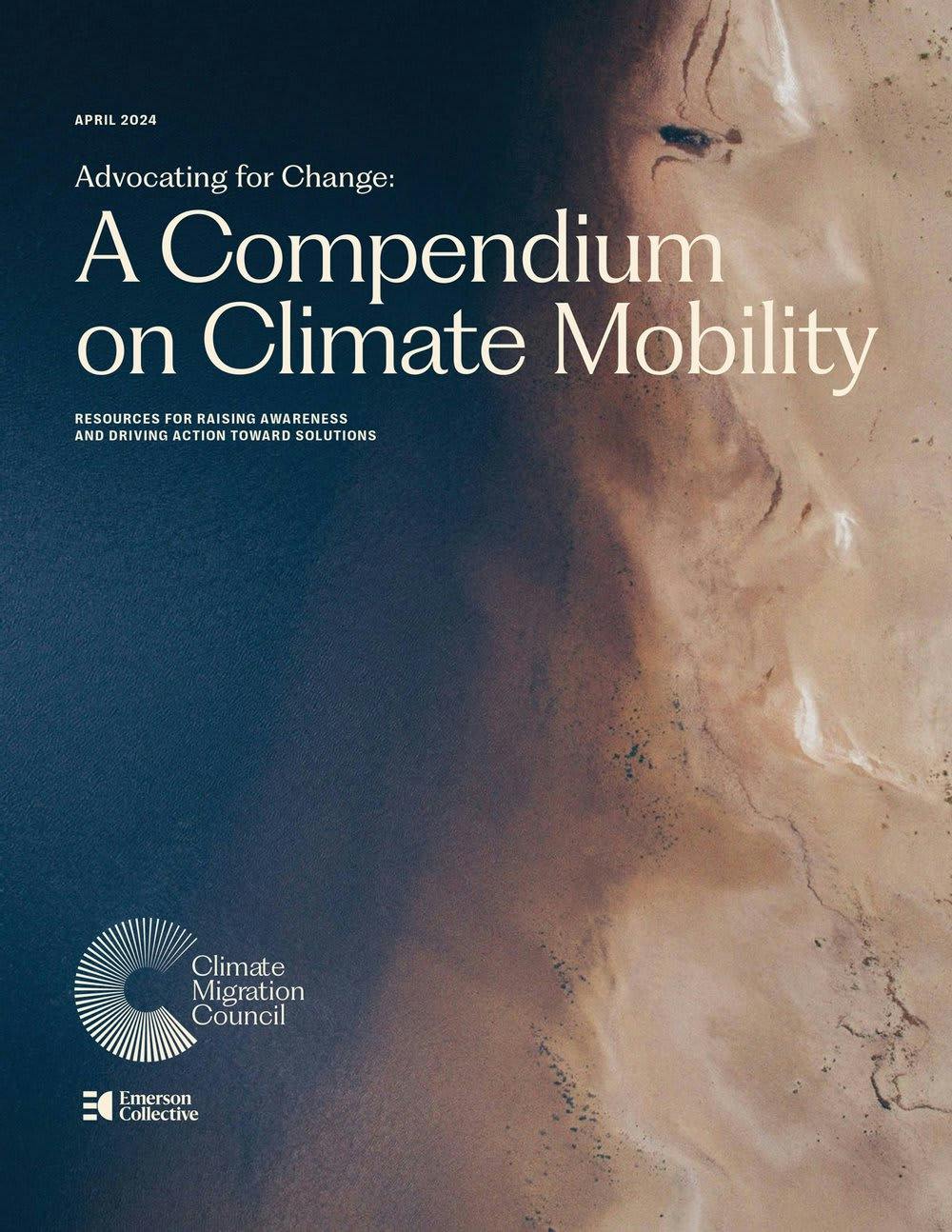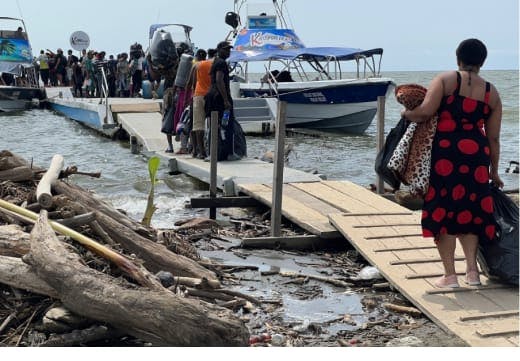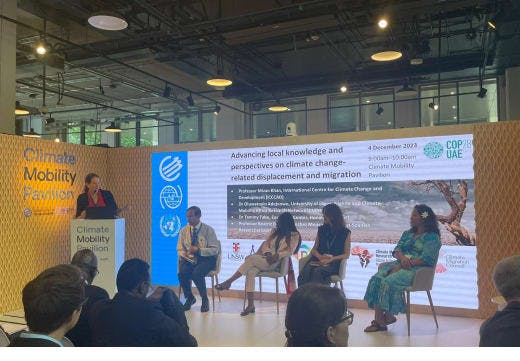
Climate Migration Council: A Compendium on Climate Mobility
100 min Read
Welcome to Emerson Collective’s Immigration Update, a monthly newsletter that seeks to make sense of important immigration-related developments by situating them in broader policy, political, and human contexts.
In this edition, we cover several important developments to close out 2023, including a troubling congressional debate over new border policies that is overshadowing otherwise meaningful progress at both global and local levels. Please continue reading for more on those legislative machinations, as well as regional migration observations from a recent trip to Colombia, climate migration developments at COP28, and migration financing breakthroughs at an inaugural convening of hemispheric leaders. As always, thank you for reading.
From all of us at the Immigration team at Emerson Collective, we send our best wishes for a peaceful holiday season and a promising, prosperous new year!
Marshall Fitz
Managing Director of Immigration
In October, the White House sent Congress a request for $106 billion in emergency supplemental funding to support Ukraine, Israel, and Taiwan. As we highlighted in our October update, this request included significant additional resources ($13.6B) to expand and strengthen migrant processing capacities at the U.S.-Mexico border as well as invest in hemispheric migration solutions.
This request for additional funds emerged in response to the record levels of people on the move throughout the Western Hemisphere, many of whom continue to arrive at the U.S. southern border, creating humanitarian challenges and fueling political backlash. What was unique in the Administration’s request was the holistic approach to addressing these challenges, especially its willingness to look at solutions beyond the historic myopic focus of both parties on border enforcement. They specifically requested resources – as we have been calling for:
to support countries in the region that are hosting and integrating large numbers of migrants, thereby reducing the likelihood of secondary migration;
to expand access to legal pathways and processing in the region to limit the need for migrants to make dangerous journeys;
to boost engagement of the private sector and multilateral partners; and
to support communities in the U.S. that are receiving and integrating large numbers of migrants.
In addition to the significant proposed investments in border infrastructure and processing, focusing additional resources on these goals would go a long way to establishing a more safe and orderly system for managing the millions of people who have been displaced in the region.
Unfortunately, congressional Republicans have hijacked the legislative process to pursue extreme changes to immigration policy. The GOP has demanded changes that would, among other things, handcuff the Administration from establishing new legal pathways, dramatically restrict access to asylum, create more chaos and humanitarian challenges on the Mexican side of the border, increase racial profiling, and significantly expand detention of immigrants in the U.S. interior.
In their desire to uphold our commitments and deliver aid to U.S. allies, the Biden Administration and some Senate Democrats have concluded they must negotiate despite the extreme nature of the demands. There are, of course, measures upon which compromise may be painful, but possible. But the politicians with whom they are negotiating will never agree to meet in the middle. We have seen exactly this dynamic throughout these negotiations, driven in part by the fact that a large portion of the Republican conference strongly opposes security funding for Ukraine. That means their negotiators have unchecked leverage because they have nothing to lose by allowing a deal to collapse. In short, they have no incentive to back off destructively maximalist demands.
We cannot begrudge the efforts of the White House to find a way forward – they believe there is a profound national interest in supporting strategic allies. The fundamental problem is that even if they accept all the extreme policy changes demanded by the GOP, the challenges at the border will remain. Historic numbers of people are on the move in the hemisphere for an array of compelling reasons that have nothing to do with our border enforcement policies. If we don’t find balanced ways to promote stability and manage that movement, the pressure and chaos on borders and national governments – including the Biden Administration – will only grow, increasing the desperation and misery of those affected.
Policy shifts diminishing the flexibility of the executive branch to manage complex dynamics at the border will not improve order and control. And, without demonstrable progress at the border, it is folly to believe that making these concessions will provide a buffer against relentless political attacks on the president’s management of this issue.
A delegation from Emerson Collective visited Necocli, Colombia, the jumping off point for most migrants into the Darien Gap. The visit bluntly exposed the core problems with the current migration management paradigm – and the false promise of border-centric policy solutions. As the Washington Post editorial board and top U.N. leaders persuasively argue: border enforcement and deterrence tactics have failed to bring order to the system and will not work without broadening the suite of interventions.

The Darien Gap, which once stood as a virtually impenetrable barrier to human mobility, is now the migration route for hundreds of thousands of people every year. A few numbers to illustrate this point:
In 2021, 150,000 people crossed the Darien, more than the 10-year total from 2010 to 2020.
In 2022, 250,000 made the trek.
In the first eleven months of 2023, more than 500,000 migrants have already crossed.
Of these 500,000 migrants, roughly half of them are women and children.
U.S. policymakers too often focus their efforts on blocking the last step of the migration journey by preventing border crossings at the U.S.-Mexico border through strong-arm enforcement measures. Instead, they should attend more diligently to reducing those factors driving migrants to take the first or second step in the journey. A critical and obvious way to do so is by investing in migrant and climate vulnerable communities as well as in the countries and cities throughout the Americas that are hosting millions of people who have already been displaced.

A recent “City-led Integration Forum” in Barranquilla, Colombia – a city where 11% of the population is now foreign-born – showcased best practices and opportunities for the integration of migrants and refugees in Latin American cities. The conversations demonstrated the great potential for collaboration with Mayors and municipalities in supporting and stabilizing migrants to reduce migration flows. As several Forum panels highlighted, innovative financing is critical to achieve this objective.
Of the tens of billions of dollars in humanitarian assistance provided in 2022, only 1.2% ($485M) went directly to local actors, including cities. Similarly, integration and economic inclusion programs that enable migrants to embed in local communities are severely underfunded. For example, 72% of OECD countries’ funding for refugees is solely humanitarian, ignoring the longer-term inclusion and development needs of refugees and host communities.
Unless these trends are reversed and bolder investments are made in stabilizing and integrating populations in countries and cities beyond the US border, we will continue seeing hundreds of thousands putting their lives at risk and creating resource pressures on communities throughout the Americas. That is a recipe for more human suffering, more alienation, and more polarizing politics.
The urgency of developing better approaches to managing migration is perhaps most acutely apparent when considering the escalating climate crisis. So, we enthusiastically welcomed a number of breakthrough commitments – including on migration – made during the annual gathering of nation-states to address climate change challenges.

The first day of COP28 yielded a commitment to operationalize the Loss and Damages Fund, which is intended to galvanize financial support from high emitting wealthy nations for the communities most impacted by, and least responsible for, climate change. And on the last day of COP, countries reached consensus on the need to “transition away from fossil fuels”, marking the first time the full global community has acknowledged the imperative of phasing out their use. Other significant agreements were reached as well including aggressive restrictions on methane emissions and the protection of critical ecosystems.
Despite this important progress, the warming that is already occurring is making parts of the globe increasingly impossible to live in. Climate change is accelerating the movement of people within and across borders because of desertification, drought, sea level rise, and intensifying storms. For millions of people, migration has become a matter of survival as we detailed in this Climate Migration Explainer.
As a result, dozens of groups, including the Climate Migration Council, came to COP28 demanding that state representatives incorporate climate migration into their national policies and their global commitments on climate. Their efforts significantly advanced the conversation around the intersection of climate impacts and human mobility. First, the agreement to operationalize the Loss and Damages Fund includes specific references to the need to promote “equitable, safe, and dignified human mobility, in cases of temporary and permanent loss and damage.” Second, COP28’s Global Stocktake includes three references to people displaced in the context of climate crisis, and calls for countries to support, minimize and address loss and damages associated with people displaced by climate change.
Small as it may seem to have climate-induced human displacement merely mentioned, these outcomes reflect hard-won consensus and should be understood as real progress. As the head of the UNFCC indicated, we are at the beginning of the end of the fossil fuel era. And advocates for human-centered climate action can take inspiration in knowing that COP outputs are often a lagging, not leading, indicator of progress. Innovative leaders, academics, and policymakers are in the vanguard of climate action, incubating and developing solutions to enable people to safely remain in their homes or to migrate with dignity. In the words of a youth activist from Samoa whose island is at risk of sinking into the sea: “we’re not drowning, we’re fighting.”
To realize the goals of managing migration in a humane and orderly way in an age of unprecedented human displacement, national governments and international institutions will need to financially invest in migrant vulnerable communities and host countries in a deep and sustained way. This will require a durable commitment to the goals of tackling inequality, generating economic opportunity, and strengthening democracy. In June 2022, at the Summit of the Americas, leaders of the Western Hemisphere formed a partnership to pursue those precise goals through deepened economic integration.
The Americas Partnership for Economic Prosperity (APEP) held its inaugural summit in Washington, DC in November and, while the summit focused on promoting inclusive growth and strengthening supply chains throughout the region, it also generated commitments focused specifically on expanding “infrastructure and social services for migrants and their host communities.”
In fact, President Biden announced that the U.S., in conjunction with a number of countries, is unlocking $89 million for the Inter-American Development Bank’s (IDB) Grant Facility to “support countries in the region most impacted by migration.” Leveraging multilateral development banks in this way is critical to build durable solutions since they are less sensitive to the whims of changing political priorities. Stabilizing communities that are hosting migrants and refugees by investing in core integration measures must be a long-term investment project, one well suited to international financial institutions.
Increasingly, the U.S. and other national governments have come to understand that strategically investing in these communities can both catalyze economic growth and stabilize migration flows. The Biden Administration is putting significant funding behind that proposition, by deploying nearly $485 million through USAID “to assist migrants and refugees, hosting communities, and vulnerable populations in the Western Hemisphere.”
Given the scale of the challenge with tens of millions of displaced people, these investments represent important progress, but remain deeply insufficient. The White House supplemental budget request, described above, included even broader investments in the region – a recognition of the need to scale these supports that we strongly applaud. If managed properly and resourced strategically, migration can be a triple win: for the migrants, as well as for both the sending and receiving communities. All it takes is the political will.